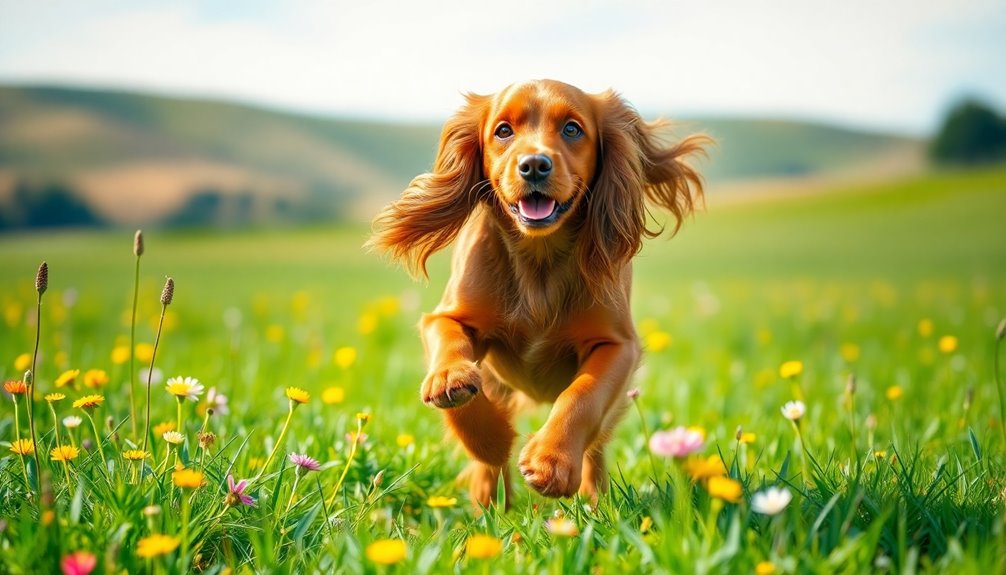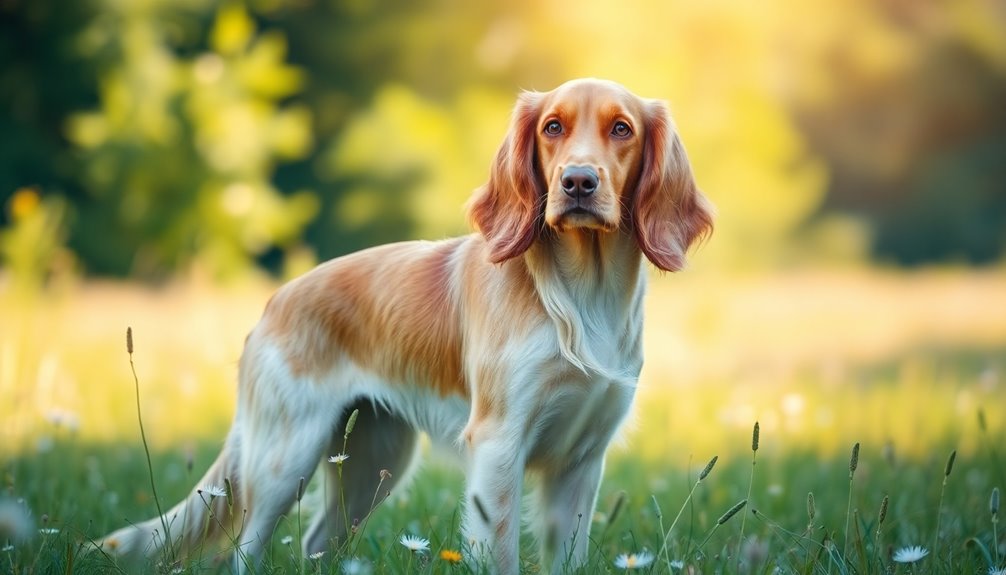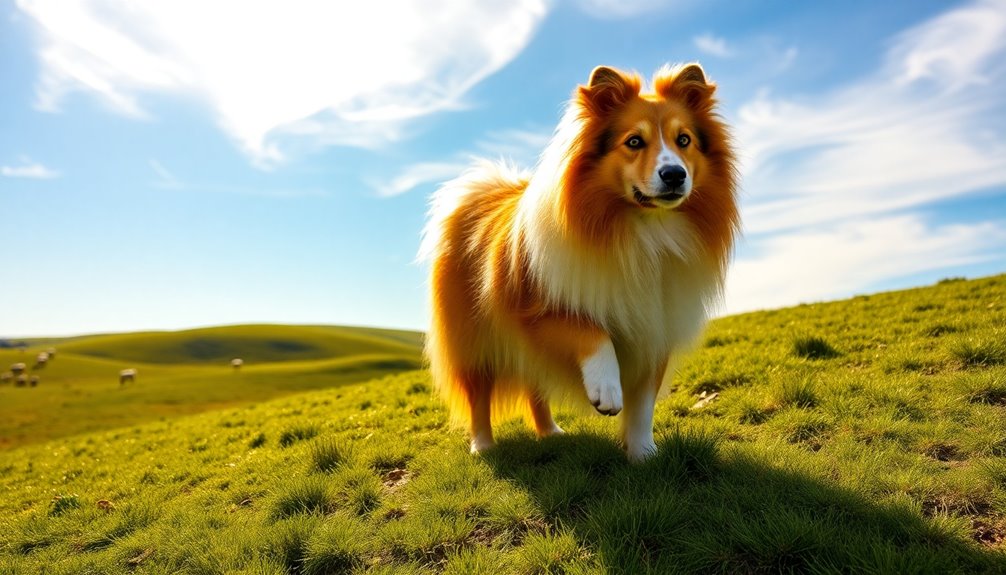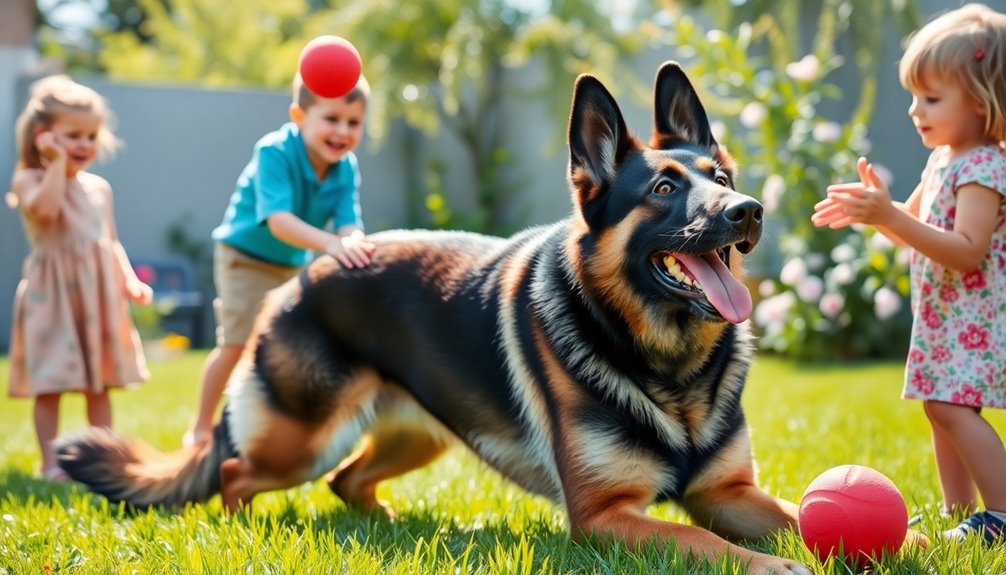The English Cocker Spaniel is a loving and versatile companion, perfect for families and active individuals alike. Weighing 26-32 pounds and standing 14-17 inches tall, this medium-sized breed boasts a soft, silky coat. Their friendly and loyal nature makes them great with children and other pets. With a high energy level, they thrive on daily exercise and mental stimulation. Regular grooming helps maintain their beautiful fur and prevent health issues. If you're curious about their training, living environment, or historical background, you'll find plenty more fascinating insights ahead!
Key Takeaways
- English Cocker Spaniels are medium-sized, affectionate companions that thrive in family environments and get along well with children and other pets.
- They require 20-40 minutes of daily exercise, making them versatile for both active and calm lifestyles.
- Their soft, silky coats come in various colors and require regular grooming to maintain health and prevent matting.
- They have a lifespan of around 11.44 years and are prone to certain health issues, making regular veterinary check-ups essential.
- Effective training using reward-based methods and early socialization is crucial for their development and to build confidence.
Introduction

When you think about a family-friendly dog, the English Cocker Spaniel often comes to mind. With a sturdy, medium-sized body and charming floppy ears that reach past the tip of their nose, these dogs are undeniably adorable. Their soft, silky fur feathers beautifully on their ears, legs, and torso, making them not just a joy to look at but also to pet. Weighing between 26-32 pounds and standing 14-17 inches tall at the withers, they're perfectly sized for families.
Temperament-wise, English Cocker Spaniels are loving, affectionate, and loyal companions. They're friendly and sociable, getting along well with people, children, and other pets when properly socialized. Additionally, their trainable nature makes them eager to please and responsive to positive reinforcement during training sessions.
While they've a high energy level, they maintain a calm demeanor, although they may bark and have a strong prey drive for smaller animals. Caring for them includes providing 20-40 minutes of daily exercise and regular grooming to keep their coats healthy.
Special attention to their ears is essential to prevent infections. Overall, the English Cocker Spaniel makes an excellent addition to any active household looking for a loving and devoted friend.
History and Origin
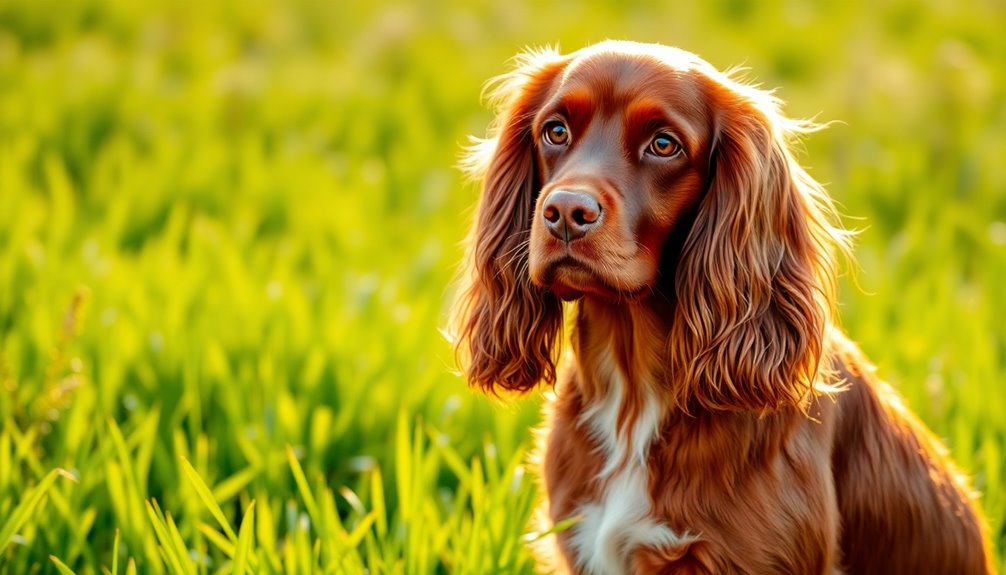
The English Cocker Spaniel traces its roots back to Spain in the 1300s, where it began as a hunting companion. By the 1800s, breeders in Britain refined the breed, focusing on its skills as a field trial hunting dog. This specialization made the Cocker Spaniel a trusted partner for flushing game in dense cover. The late 1800s marked a significant period when differences in weight and height became more pronounced among the spaniel breeds.
Where and when the breed originated
Originating from Spain, the English Cocker Spaniel has a rich history that dates back to at least the 1300s. Most historians believe that spaniels, as a group, trace their roots to the Iberian Peninsula, where their hunting capabilities were first recognized. As the breed developed, it spread to Wales and the southwestern regions of England, where British breeders refined these dogs for specific hunting tasks.
By the 16th century, early versions of the Cocker Spaniel emerged, with the British playing a crucial role in shaping what we know today. Initially, cocker and springer spaniels shared litters, but over time, distinctions became clearer. In fact, by the 17th century, these distinctions were largely based on size and hunting roles.
By the late 1800s, spaniels were categorized into "springing" and "cocking" types. The establishment of The Kennel Club in the UK in 1873 led to more formal recognition and pedigree recording. In 1892, the English Cocker Spaniel was officially recognized as a separate breed. This standardization continued through the early 1900s, ultimately resulting in the English Cocker Spaniel Club being founded in 1902 to promote and maintain the breed's unique characteristics.
Field Trial Hunting Companion
Field trials have long been a vital aspect of showcasing the English Cocker Spaniel's exceptional hunting abilities. The first field trial for Spaniels in the United States took place in late 1924 at Fisher Island, New York, marking the beginning of a proud tradition.
By December 6, 1925, the Hunting Cocker Spaniel Field Trial Club of America, largely founded by Mrs. Ella B. Moffit, held its inaugural stakes at Verbank, New York. Early trials included both Cocker and Springer Spaniels, without breed distinctions, highlighting the versatility of the breed.
Notable figures like Freeman Lloyd and judges such as Elias Vail played crucial roles in guiding the training and evaluation of hunting cockers. The first National Cocker Field Trial in 1953 showcased the breed's talents, with NFCH Camino's Cheetah emerging victorious. In the years following, the Cocker Spaniel National Championship faced challenges that ultimately led to its discontinuation in 1965.
Although Championship Field Trials were discontinued in 1965, renewed interest has sparked a resurgence in modern participation.
Today, English Cocker Spaniels demonstrate their hunting prowess through various field trials and hunt tests. With their strong instincts and eagerness to please, they remain cherished companions for any hunting enthusiast.
Physical Characteristics
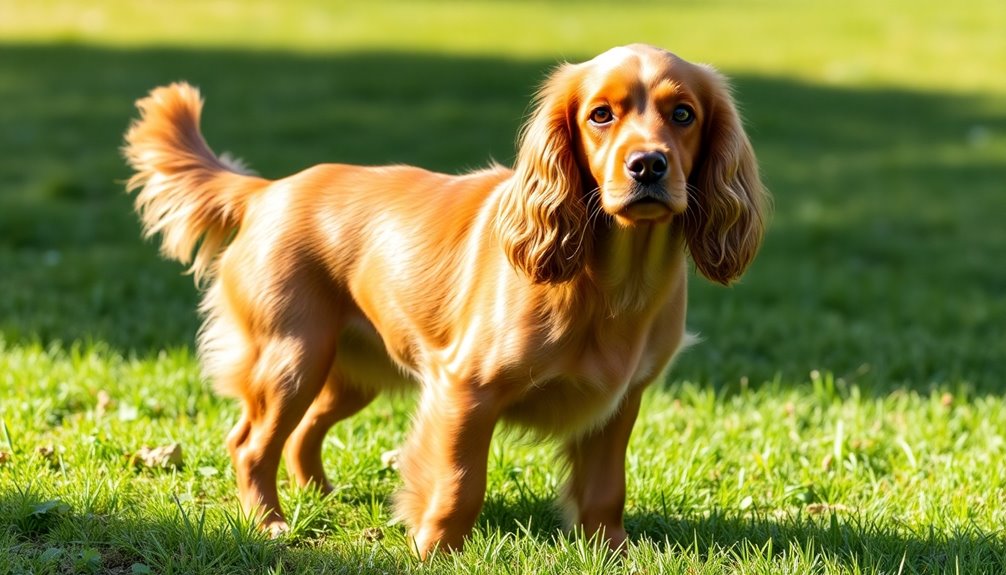
When you look at an English Cocker Spaniel, you'll notice a sturdy, compact build that showcases its lively personality. Males typically stand between 15-17 inches tall and weigh around 28-34 pounds, while females are slightly smaller. Their medium-length coat, adorned with feathery fringes on the legs and ears, adds to their charming appearance and requires regular grooming to keep it looking its best. This breed is known for its friendly and affectionate nature, making it a beloved companion for families and individuals alike.
Size, weight, and coat details
The English Cocker Spaniel is a compact and athletic breed, characterized by its medium-sized build and well-balanced proportions. Males typically stand between 15½ to 16 inches tall, while females are slightly shorter at 15 to 15½ inches. On average, males weigh around 28 to 34 pounds, whereas females weigh between 26 to 32 pounds. You'll notice that working Cockers tend to be trimmer than their show counterparts.
Their coat is a double-layered delight, featuring a soft, dense undercoat and a long, curly or wavy outer coat. This breed comes in a variety of colors, including black, golden, red, and parti-colors. Regular grooming is essential to keep their coat free from matting and tangling, especially around the ears and legs. It's important to monitor their weight, as ideal weight range should be maintained to ensure their overall health and prevent obesity-related issues.
As moderate shedders, you may find that they shed more during seasonal changes. It's crucial to maintain their coat not only for aesthetics but also for health reasons, as proper grooming can help prevent skin issues and reduce the risk of ear infections.
Feathery Leg and Ear Fringes
English Cocker Spaniels show off their distinctive feathery leg and ear fringes, which add to their charm and elegance. To keep those leg fringes looking their best, remember they shouldn't touch the ground. Trim them as needed, shaping the hind leg feathers around the stifles so they reach just to the knuckle and taper neatly.
From the front, ensure the feathering lies back naturally from the elbow. For a clean look, remove any long, straggly hairs from the forelegs.
When it comes to ear fringes, trim about one-third of the total length for a balanced appearance. If you have a pet, consider shaving the entire ear leather to improve airflow, but for show dogs, keep the ear fur full to meet breed standards. Regular grooming not only enhances the appearance of the fringes but also promotes coat health.
Always be cautious when trimming the inner ear leather to prevent discomfort or infection, and ensure the fur is even to avoid matting.
To maintain these fringes, use scissors and thinning shears for blending, and always comb thoroughly to remove unwanted hair. This attention to detail not only enhances their beauty but also supports their overall health and mobility.
Temperament and Personality
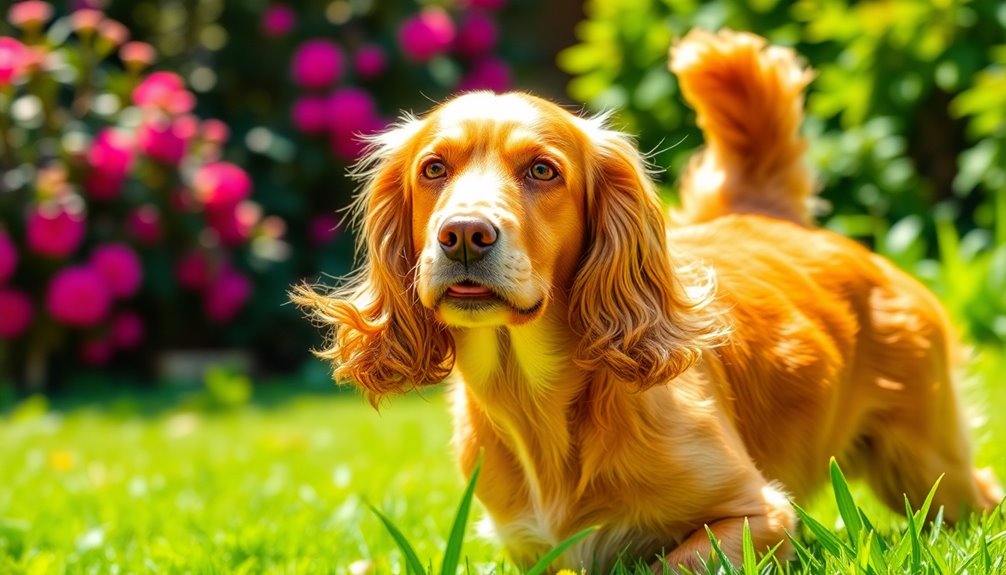
When you think of an English Cocker Spaniel, picture a playful and eager-to-please companion that's perfect for families, individuals, or even other pets.
Their friendly nature makes them great additions to any household, and they thrive on social interactions. With their loyal disposition, these dogs form strong bonds that enrich your life and theirs. They require daily exercise to keep their high energy levels in check, making them ideal for active families or individuals.
Playful and Eager to Please
How can one resist the charm of a playful English Cocker Spaniel? They're always ready to engage in fun activities like tug-of-war or chasing a ball.
These dogs thrive on regular exercise, so daily walks and playtime in the yard are essential to keep them happy and healthy. To prevent boredom, mix it up with fetch, agility training, or off-leash runs in safe areas. Their playful nature also extends to mental stimulation, so incorporating games that challenge their sharp minds is a must. This breed's high energy level means they require approximately 45-90 minutes of exercise daily to stay fit and content. Additionally, ensuring they have a balanced diet is crucial for maintaining their energy levels and overall health, including high-quality protein sources to support their active lifestyle.
English Cocker Spaniels are eager to please, ranking 18th in Stanley Coren's *The Intelligence of Dogs*. They learn new commands quickly and respond well to positive reinforcement, like treats and praise. This makes training a joyful experience, though they require patience and gentle methods to avoid fear or anxiety.
With their affectionate demeanor and preference for human companionship, these dogs form strong bonds with their families. They're social and get along well with children and other pets when properly socialized.
Their playful spirit and eagerness to please truly make them delightful companions.
Suitability for families, individuals, or other pets
With their friendly and affectionate nature, English Cocker Spaniels make wonderful companions for families and individuals alike. They thrive in family settings, bonding closely with members and often becoming known as "velcro dogs." Their gentle temperament makes them excellent with children, though it's essential to supervise interactions to prevent stress or rough handling. Early socialization helps ensure they get along well with everyone in the household.
For individuals, these dogs adapt easily to various living situations, whether in apartments or homes with backyards. They crave human companionship, making them ideal for those who spend lots of time at home. Regular exercise and mental stimulation are crucial to keeping them happy, so daily walks and activities like agility training are a must. Their strong desire for companionship also means they thrive in settings where they can interact with their humans.
When it comes to other pets, English Cocker Spaniels typically get along well with dogs and can bond with cats, given their low prey drive. Proper introductions and a harmonious environment are key to successful interactions.
While they may need a bit of supervision at first, their sociable nature usually helps them integrate smoothly into a multi-pet household.
Health and Lifespan
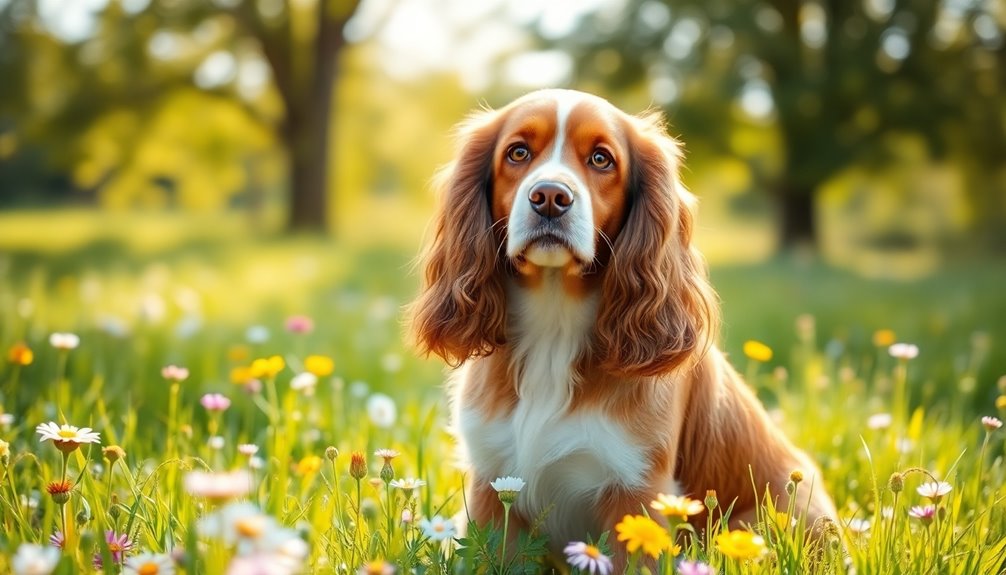
When it comes to the health and lifespan of your English Cocker Spaniel, you'll find that they typically live around 11.44 years, with females usually outliving males.
It's crucial to be aware of common health issues like dental disease and ear infections that can affect your pup. Regular veterinary check-ups are essential for early detection of health issues to keep your dog thriving.
Typical lifespan of the breed
The typical lifespan of an English Cocker Spaniel averages around 11.44 years, though this can vary based on several factors. On average, females tend to live longer, around 12.01 years, compared to males, who average about 11.00 years. This lifespan aligns closely with the general average for dogs in the UK, which is 11.2 years, but some studies indicate that they can live anywhere from 12 to 15 years with proper care.
Genetics, diet, and overall care significantly influence their longevity. Ensuring your dog has a balanced diet, regular exercise, and preventive healthcare can extend their lifespan. Regular veterinary visits are essential, especially as they age, to catch any potential issues early. Regular grooming is also important to maintain their silky coats and prevent skin issues.
While English Cocker Spaniels generally have a good lifespan compared to similar-sized breeds, they can face age-related problems that necessitate more frequent check-ups. Maintaining a healthy weight and paying attention to grooming, particularly ear care, can prevent infections and other health concerns.
Ultimately, the love and attention you provide play a crucial role in your Cocker Spaniel's well-being and longevity.
Common health concerns or genetic predispositions
While English Cocker Spaniels generally enjoy a good lifespan, they do face several common health concerns and genetic predispositions that owners should be aware of. One significant issue is Von Willebrand's Disease, a blood clotting disorder that requires diagnostic testing.
Familial Nephropathy, an inherited kidney disorder, can lead to kidney failure in young dogs. Additionally, conditions like Chondrodystrophy and Intervertebral Disc Disease predispose them to spinal issues. Regular veterinary check-ups are essential for early detection of these conditions.
Dental disease, affecting about 80% of dogs by age two, is particularly prevalent in this breed, making regular dental care essential. Ear infections are also common, impacting over 10% of English Cocker Spaniels annually.
Heart disease, including valve disease, is another concern that can lead to heart failure, a leading cause of death. Moreover, hip dysplasia may cause arthritis and mobility issues, while obesity exacerbates many health problems.
Progressive Retinal Atrophy can lead to blindness, and other issues like skin infections and anal sac impaction may arise. Being aware of these conditions can help you take proactive steps to ensure your furry friend lives a healthy, happy life.
Tips for maintaining health and wellness
Maintaining your English Cocker Spaniel's health and wellness hinges on a balanced approach to diet, exercise, grooming, and routine care.
Start with a high-quality diet rich in animal-based proteins like chicken or beef, balanced with healthy fats and plenty of vitamins from vegetables and berries. Avoid high-carb diets that can stress their digestive system, and tailor their meals to their age for optimal nutrition.
Exercise is crucial; aim for about an hour and a half daily. This can include lengthy walks, runs, or playtime, which helps prevent anxiety and destructive behavior. Remember, while they've boundless energy, they also enjoy downtime. It's also important to note that obesity/overweight is observed in nearly 10% of English Cocker Spaniels, so regular exercise is essential.
Grooming shouldn't be overlooked. Brush their silky coat weekly to prevent matting, and trim around their legs and torso regularly. Maintain dental health by brushing their teeth at least twice a week and clean their ears weekly to ward off infections.
Finally, stay vigilant with routine care. Schedule regular vet check-ups, adhere to vaccination schedules, and monitor for any unusual signs.
Consider pet health insurance to ease potential medical costs. Following these tips will keep your English Cocker Spaniel healthy and happy for years to come.
Care Requirements
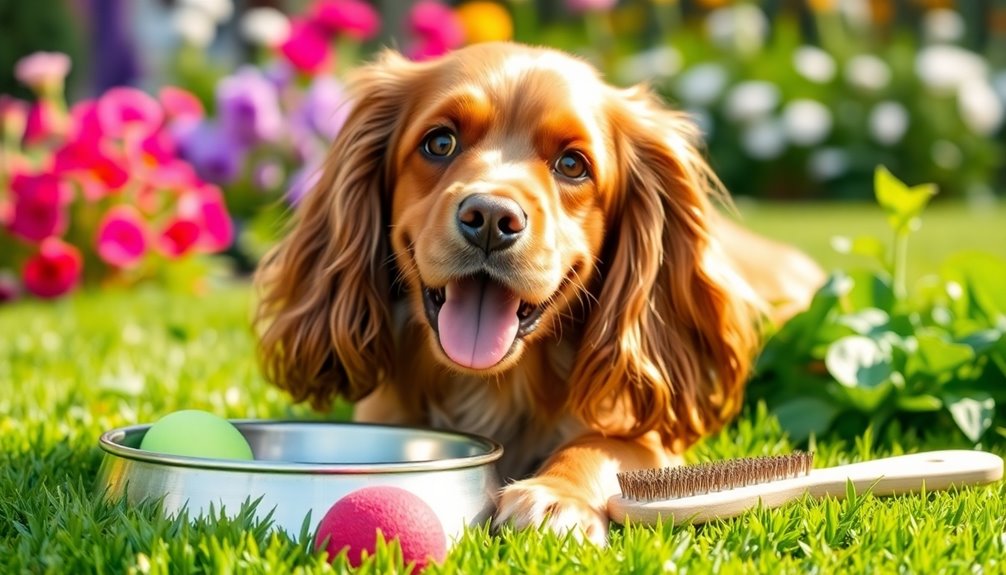
Taking care of your English Cocker Spaniel involves regular brushing to keep their coat healthy and free of tangles. It is recommended to brush at least once a week and follow up with a comb for optimal condition, using a specific care routine to maintain their coat's length and shape. You'll also need to ensure they get plenty of exercise to match their high energy levels. Finally, providing a balanced diet is essential for their overall health and well-being.
Regular Brushing Required
Regular brushing is essential for keeping your English Cocker Spaniel's coat in top condition. You'll want to brush your dog every three days to maintain that beautiful coat. If your pup loves exploring undergrowth, more frequent brushing is necessary to remove pesky debris like grass seeds and burrs.
During shedding seasons in spring and autumn, aim for daily brushing to prevent matting and minimize loose hair. Regular grooming also helps prevent matting, which can hide injuries and lead to infections.
When you do brush, use a slicker or pin brush to distribute oils and keep the coat healthy. A wide-toothed comb is vital for tackling tangles without causing damage. If your dog's coat is dry, a spray conditioner can help prevent breakage. An undercoat rake is perfect for shedding during warmer months.
Pay attention to the amount of loose hair you collect. If your brush picks up a lot, consider increasing your grooming frequency to every other day or daily. If not, you might manage with once or twice a week.
Exercise requirements and energy levels
To keep your English Cocker Spaniel happy and healthy, you'll need to provide at least 1 to 1.5 hours of exercise every day. This should include daily walks, playtime in secure areas, and various physical activities. Consider lengthy walks, running, or playing outside to burn off that high energy.
Engaging in activities like hiking, biking, or swimming can be particularly enjoyable for your pup. Fetching balls or frisbees can also provide great playtime.
Don't forget the mental stimulation; puzzle toys and obedience training are essential for keeping their minds sharp. Regular physical and mental challenges are crucial for overall well-being.
Puppies require shorter sessions, about 5 minutes of exercise per month of age, increasing gradually. By 12 to 18 months, they reach their full exercise capacity.
Senior dogs, however, need 30 to 60 minutes daily but should have less intense activities to protect their joints.
If your English Cocker Spaniel doesn't get enough exercise, you might notice anxious behavior or destructive habits. These adaptable dogs thrive on consistent activity and mental challenges, ensuring they stay well-mannered and content.
Feeding tips and diet recommendations
Maintaining a balanced diet is just as important as meeting your English Cocker Spaniel's exercise needs. Focus on high-quality, animal-based protein sources like beef, chicken, turkey, and fish, as protein is vital for your dog's overall health. A raw food diet can promote overall health and happiness in dogs, making it a worthy consideration. Include healthy fats to provide energy and support wellness; both saturated and unsaturated fats are necessary for your pup. A small amount of carbohydrates from vegetables and fruits can offer essential fiber and antioxidants.
You might consider a raw food diet to help prevent health issues like obesity and joint problems. However, if you opt for conventional kibble or wet food, steer clear of high-starch options. For skin and coat health, look for key nutrients like omega-3 fatty acids and vitamin A.
When it comes to feeding, adult Cocker Spaniels typically require 1.5 to 2.5 cups of food daily, split into two meals. Puppies need three meals a day until six months, then transition to two.
Regularly monitor your dog's weight due to their susceptibility to obesity. Always provide fresh, clean water and adjust their diet according to climatic conditions and activity levels.
Training and Socialization
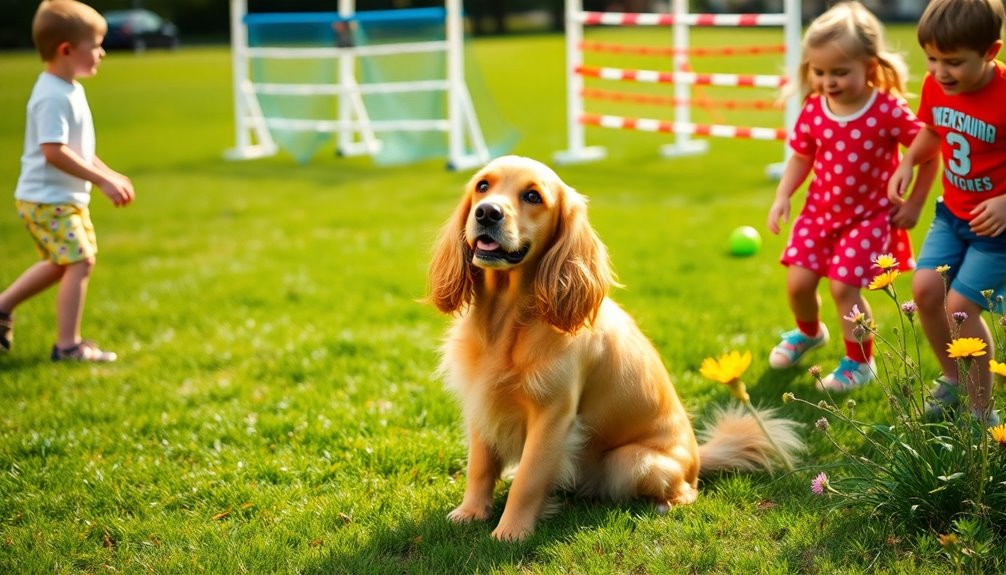
When training your English Cocker Spaniel, you'll find they're highly responsive to commands, making it easier to teach them basic behaviors. It's crucial to gradually expose them to new environments to build their confidence and reduce anxiety. Early socialization helps to reduce fear and anxiety in various situations, ensuring your puppy grows into a well-adjusted adult dog. Incorporating positive reinforcement techniques can enhance the training experience and strengthen the bond between you and your dog. Keep an eye on potential leash pulling during walks, and use consistent techniques to encourage better leash manners.
Highly Responsive to Commands
English Cocker Spaniels are known for their eagerness to learn and respond to commands, making them wonderful companions for training. To effectively train your Cocker, use repetitive, reward-based methods. Positive reinforcement with treats, praise, and affection works wonders due to their sensitive nature.
Avoid harsh corrections; instead, use luring techniques with treats to teach commands like "sit" and "stay." Implement click and reward timing to reinforce their actions accurately.
Start training as soon as you bring your puppy home. Focus on basic commands like "down," "come," "stay," and "heel." Consistency is key, so use the same commands and hand signals to prevent confusion. Early socialization with other dogs is also essential, as it encourages healthy interactions and reduces anxiety.
Keep training sessions short, fun, and engaging to maintain their interest. Establish a structured training plan that integrates a daily routine, including sleeping, eating, playing, and socialization. This consistency helps your puppy feel secure and enhances their responsiveness.
Gradual Exposure to New Environments
Gradually exposing your English Cocker Spaniel to new environments is essential for their development and confidence. Start this process early, ideally between 3 to 14 weeks of age, to help them adapt to different people, animals, and surroundings.
Begin in familiar environments like your home or backyard, introducing small changes such as new toys or blankets. As you progress, move to quieter areas, like parks or pet-friendly stores. Engage your dog with familiar toys or games to make these new experiences enjoyable. Incorporate consistent routines to provide a sense of security as they navigate new situations.
Always reward calm behavior, and if your pup shows signs of discomfort, retreat and try again later. Observe their reactions closely and adjust the pace based on their comfort level. Use positive reinforcement to help them feel at ease with new sounds and surfaces, allowing them to explore different terrains like grass or concrete.
Leash Pulling During Walks
After helping your English Cocker Spaniel adapt to new environments, it's time to tackle another common issue: leash pulling during walks. To address this, focus on training techniques that promote loose leash walking. Start by rewarding your dog with treats when it takes steps toward you. Practice in various open areas, keeping sessions short—just 1-2 minutes—to maintain their interest. Regular outings to dog-friendly environments will also aid in your dog's overall socialization and confidence.
When your dog pulls, stop moving or change direction to discourage the behavior. Use a headcollar or harness for better control, and allow them to move forward only when the lead is slack. Consistency is key, so ensure you regularly reinforce training. Studies indicate up to 80% improvement in leash behavior when these techniques are applied over time.
Hold the lead correctly, coming from the left side, and avoid unnecessary tightening.
Socialize your dog when calm, reinforcing desired behavior with treats or toys. Introduce a cue like "By Me" once they consistently walk beside you.
Ideal Living Environment
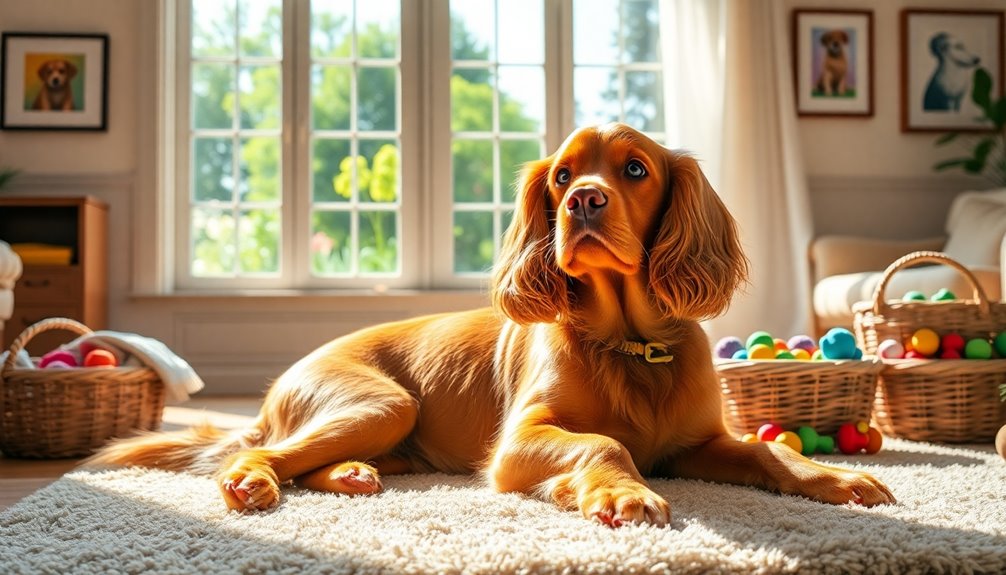
When considering an ideal living environment for your English Cocker Spaniel, a house with a secure fence is essential to keep them safe while they play. These dogs adapt well to moderate temperatures, so ensure they've a comfortable space year-round. Creating a balanced environment fosters their happiness and health, allowing them to thrive in your home. Additionally, providing ample opportunities for high exercise requirements can significantly contribute to their overall well-being.
House With a Secure Fence
Creating a safe haven for your English Cocker Spaniel involves more than just love; it requires a secure, fenced environment that protects them from potential dangers.
For medium-sized dogs like yours, a fence should be at least 4-5 feet tall, preventing any jumping or climbing attempts. Opt for smooth surfaces using materials like vinyl or composite to avoid injuries. Additionally, consider the behavior of your dog, as high-energy dogs may require even taller and sturdier fences to prevent escapes. Regular veterinary care is also important to ensure your dog remains healthy and well-adjusted.
To prevent digging, consider installing a barrier such as wire mesh or chicken wire at the base. You can also use concrete or rocks to deter digging, and a footer extending slightly above ground is effective. Train your Cocker Spaniel with positive reinforcement to discourage digging.
Gate security is vital; ensure your gates are lockable and the same height as the surrounding fence. Dual-gate entrances help control access, while secure hardware allows for effortless closing and latching.
Make sure your yard is completely enclosed with fencing materials like wood or chain-link, and check for any gaps or weaknesses. Regularly inspecting your fence can help maintain your dog's safety and prevent unexpected escapes.
Moderate Temperature Adaptability
A secure home environment is just one aspect of ensuring your English Cocker Spaniel thrives. You'll need to consider their moderate temperature adaptability to keep them comfortable and healthy.
While they can handle various climates, precautions are essential during extremes. Their thick, medium-length coat offers some insulation against the cold, but they aren't as tolerant of frigid weather as breeds from snowy regions. Make sure to provide them with a warm space during winter months. Additionally, their soft, silky coat requires attention, as proper grooming helps maintain their comfort in varying temperatures.
In hot weather, it's crucial to offer access to plenty of water and shady spots to prevent overheating. Though they can cope better than short-coated breeds, you should monitor their activity levels in the heat.
Regardless of your living situation—whether it's a small apartment or a larger home—your Cocker Spaniel needs daily exercise and social interaction. Regular walks, play sessions, and engaging activities will keep them happy and healthy.
Lastly, don't forget about grooming. Regular brushing and ear cleaning are vital for their well-being.
Color Variety in Coat
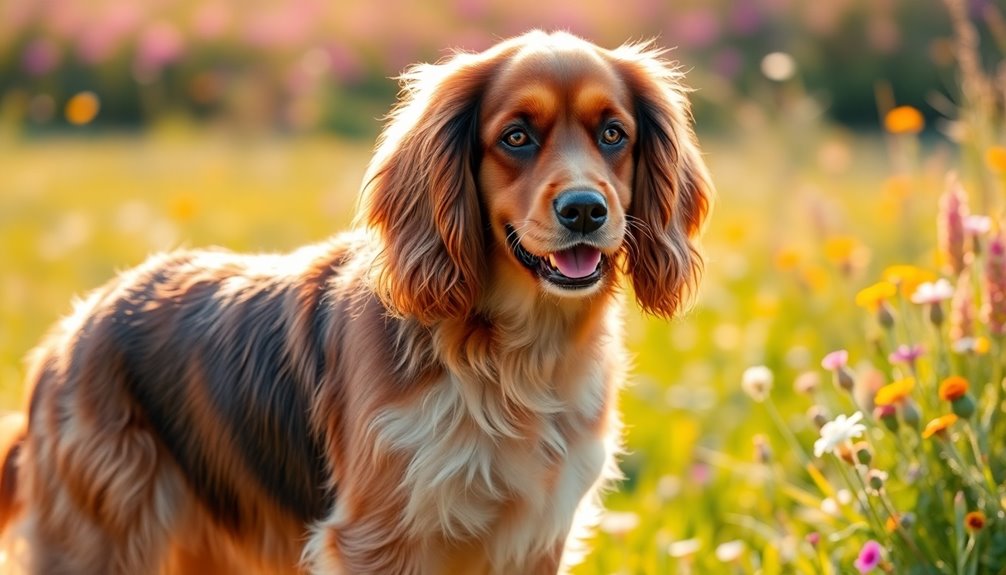
When it comes to English Cocker Spaniels, you'll find a stunning variety of coat colors that can fit any preference. From the classic black and golden shades to unique patterns like lemon roan, these dogs offer plenty of choices. Plus, if you're a fan of Disney's "Lady and the Tramp," you might even spot some familiar color combinations in your own pup! The breed is recognized for its 24 distinct colors, showcasing an impressive diversity that appeals to many dog lovers.
Variety of Coat Colors
The English Cocker Spaniel delights dog lovers with its stunning variety of coat colors. You'll find solid colors like black, golden, and liver, each offering its own unique charm. The golden Cocker Spaniel is particularly popular, often making it one of the more affordable options.
If you prefer something deeper, the rich red coat is a striking choice, while the sable coat adds a distinctive two-tone effect. This sable coat color is due to a specific genetic mutation in the MC1R gene.
In addition to solid colors, English Cockers sport beautiful particolored coats. Black and white combinations, playfully called "Oreo Spaniels," showcase a balance of dominant white and recessive black genes.
Less common liver and white or orange and white patterns create eye-catching variations.
Roan markings, such as blue roan, are another hallmark of the breed, featuring black spots on a white background. You might also encounter liver roan or combinations like blue roan and tan.
The presence of tan markings adds an extra layer of elegance, regardless of the base coat color.
With the influence of genetics, including the MC1R gene, each Cocker's coat is a unique expression of beauty, making these dogs even more endearing.
Disney's Lady and the Tramp
In Disney's "Lady and the Tramp," the character of Lady beautifully showcases the elegance and charm of the American Cocker Spaniel breed. As a pampered Cocker Spaniel, Lady embodies the breed's affectionate and energetic nature. Her life takes a turn when she meets Tramp, introducing her to a world beyond her comfortable home with Jim Dear and Darling.
Throughout the film, Lady's adaptability shines as she navigates challenges, especially when Aunt Sarah arrives with her two cats. This dynamic illustrates the American Cocker Spaniel's friendly and playful temperament, making Lady a relatable and lovable character. Additionally, the film was directed by notable Disney directors such as Hamilton Luske and Clyde Geronimi, showcasing the high level of artistry involved in bringing Lady's story to life.
Her portrayal emphasizes the breed's need for companionship and regular grooming, reflecting the commitment required from owners.
The film's heartwarming narrative has contributed to a surge in the breed's popularity, inspiring many to adopt American Cocker Spaniels. Lady's character not only highlights the breed's adorable appearance but also its sweet, loyal nature.
As you enjoy this classic love tale, you'll appreciate how Lady and Tramp's adventures resonate with the joy that dogs bring into our lives, showcasing the rich diversity and charm of canine companions.
Active Lifestyle Compatibility?
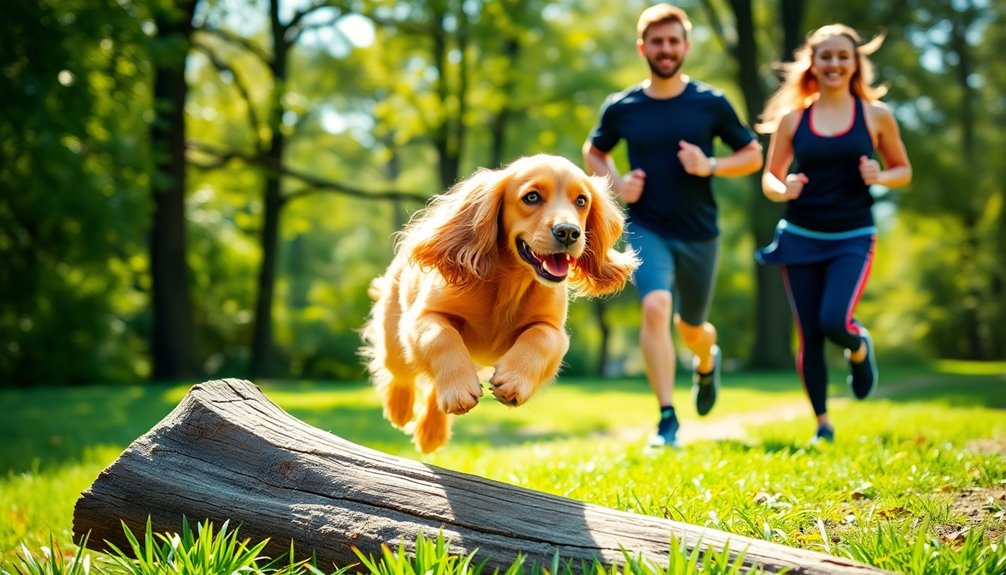
If you're looking for a family-friendly dog that fits an active lifestyle, the English Cocker Spaniel might be a perfect match.
Their adaptability allows them to thrive in various living situations, provided you give them enough exercise and playtime. With a lifespan typically ranging from 12 to 15 years, they can be a long-term companion for your family's adventures.
Plus, while their grooming needs require attention, the joy they bring to your active days makes it all worth it.
Family-Friendly and Adaptable
Many families find that English Cocker Spaniels seamlessly fit into their active lifestyles, combining affectionate companionship with the energy to keep up with busy households. These gentle and patient dogs thrive in family environments, forming strong bonds with both adults and children. Their loving temperament makes them excellent companions, provided they're treated with respect and care.
Adaptability is a hallmark of this breed. Whether you work outdoors or prefer a cozy day at home, they'll adjust to your routine. They can happily live in apartments or houses with backyards, as long as they get plenty of exercise. Proper training is essential for ensuring they remain well-behaved and integrated into family life.
However, keep in mind that they don't like being left alone for long periods, as this can lead to separation anxiety.
When it comes to kids, English Cocker Spaniels are friendly and eager to please, making them great playmates. It's crucial to teach children how to interact gently with them to prevent any stress or aggression.
With early socialization and proper training, these dogs can harmoniously integrate into your family, enhancing your active lifestyle while providing endless love and companionship.
Grooming Needs and Maintenance
Maintaining the grooming needs of an English Cocker Spaniel is key to keeping them healthy and happy, especially in an active household. You should brush their coat at least once a week, or twice a day for fluffier dogs, using a medium slicker or pin brush. A wide-toothed comb helps remove tangles and prevents matting, especially in areas like the ears. Always brush in the direction of hair growth to avoid damage.
Bathing is essential too; aim for every 14 days or more often if they're particularly active. Use a suitable shampoo and conditioner to keep their coat shiny and healthy. Blow drying the coat after bathing is important to prevent moisture-related issues and maintain coat health. A leave-in spray conditioner can ease brushing and prevent tangles. Trim their coat every 6-8 weeks to maintain the desired shape, focusing on the underbelly and legs with clippers.
Don't forget to check their ears weekly for debris and trim nails regularly to prevent overgrowth. Daily teeth brushing ensures good dental health.
With consistent grooming, you'll keep your English Cocker Spaniel looking and feeling their best, ready for all your family adventures.
Frequently Asked Questions
How Much Do English Cocker Spaniels Typically Weigh?
English Cocker Spaniels typically weigh between 11.75 to 15.5 kg for males and 11.75 to 14.5 kg for females.
That's about 26 to 32 lbs for both genders.
To ensure your dog's weight stays within this range, keep an eye on their diet and activity levels.
Genetics also play a role, so consider their parents' sizes.
Regular monitoring is key to preventing obesity and maintaining their overall health.
Are English Cocker Spaniels Good With Children?
Yes, English Cocker Spaniels are great with children! Their gentle and affectionate nature makes them ideal companions for families.
They enjoy playtime and adapt well to various energy levels, but they do require supervision to ensure safe interactions. Early socialization and positive training help them become well-adjusted.
Just remember to handle them gently, as they're sensitive, and provide the attention they crave to keep them happy and secure.
What Grooming Tools Are Best for This Breed?
For grooming your dog, you'll want to use a slicker brush to tackle loose hair and tangles, especially if they've a longer coat.
A pin brush works well for the ears and tail, while a bristle brush adds shine.
Don't forget a wide-toothed comb to prevent knots.
For trimming, clippers with appropriate blades and grooming scissors are essential.
Lastly, a metal comb helps with matting, ensuring a well-groomed look!
How Often Should I Exercise My English Cocker Spaniel?
You should exercise your English Cocker Spaniel for about 45 to 90 minutes each day.
Split this time into two sessions of moderate activities like walking and play. Daily strolls, along with mental stimulation, are key to keeping them healthy and happy.
For adult dogs, aim for at least an hour of exercise, while puppies and seniors need tailored routines based on their age and health.
Don't forget to mix physical and mental challenges!
Do English Cocker Spaniels Have Any Common Behavioral Issues?
Yes, English Cocker Spaniels can exhibit common behavioral issues.
Aggression, especially among males and single-coloured dogs, can arise from fear or stress. They might also be suspicious of strangers if not properly socialized.
Additionally, their sensitivity means they respond poorly to harsh training methods.
You'll need to focus on positive reinforcement and consistent training to manage these behaviors effectively, ensuring a well-adjusted and happy companion.
Conclusion
In conclusion, the English Cocker Spaniel is a versatile and loving companion, perfect for active families or individuals. With their friendly nature and eagerness to please, they thrive in social settings and enjoy plenty of playtime. By understanding their needs for training, exercise, and proper care, you'll ensure a happy and healthy life for your furry friend. If you're looking for a loyal and affectionate partner, this breed might just be the perfect match for you!

